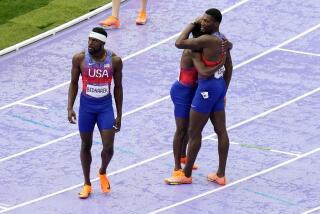U.S. Olympic Track and Field Trials Notebook : Reynolds Said He Got a Push From His Brother to 43.93 in 400 Meters
- Share via
INDIANAPOLIS — On the day after he became the first sub-44 quarter-miler in 20 years by winning the 400 meters Wednesday night in 43.93 seconds, Butch Reynolds credited his brother, Jeff.
Butch, 24, said his brother, who runs at Kansas State, came to Columbus, Ohio, two weeks before the trials to help him train.
“UCLA has a lot of 45-second quartermilers walking down the street,” Butch said. “It’s tough there. We don’t have that many in Ohio.”
Jeff, 22, must also have been helped by the workouts because he ran his first sub-45 400 meters in the quarterfinals, clocking 44.98 but failing to qualify for the next round against the strongest field of quarter-milers ever assembled.
Asked to describe the feeling of running the 400, the longest sprint, Butch said, “It’s like being told you have to hold your arms above your head all day, and that if you drop them you’ll die.”
He said he began competing in track and field when he was enrolled in a Catholic high school in his hometown, Akron.
“You had to work 100 hours to pay for your scholarship,” he said. “But the more sports you went out for, the less they made you work. So I said, ‘I’m going to go out for football, baseball, basketball, track, whatever you’ve got.’ ”
Reynolds emerged as a world-class quarter-miler last year, when he was a junior at Ohio State, by running 44.10, which until Wednesday night was the fastest time ever at sea level. Lee Evans’ ran his world record 43.86 at 7,500 feet in the 1968 Mexico City Olympics.
Reynolds soon learned that track and field is not just a sport. He’s had four business advisers in little more than a year, finally settling with Advantage International in Washington.
“It was thrust on me,” said Reynolds, who left Ohio State this year, 30 hours short of a degree, to concentrate on the sport. “The phone was ringing constantly. I bought a briefcase and everything.”
Lee Evans’ best non-altitude time: 44.95 at the 1971 Pan American Games in Winnipeg, Canada.
When Reynolds got out of the blocks Wednesday night in .155 of a second, the so-called reaction time, coaches said that was good even for a 100-meter runner.
Indeed it was.
At the 1984 Olympics in Los Angeles, half the finalists in the 100 meters did not have a reaction time that fast.
That includes gold medalist Carl Lewis, who was out in .177, and silver medalist Sam Graddy, who was out in .156.
With the women’s 200-meter qualifying beginning today, the question is how fast Florence Griffith-Joyner can run in that race. She set the world record in the 100 meters Saturday with a 10.49, which was .27 under the previous mark of 10.76. Now she’s focusing on the 21.72 world record in the 200.
“I know she’s ready to run the 200 because it’s more her race,” said Gwen Torrence, who finished third in the 100 and again will compete against Griffith-Joyner in the 200. “I’m even looking for her to run 20-point-something.”
Of the 10.49, Torrence said: “That didn’t happen, a nightmare. I’m just going to forget about it. People are calling me and saying, ‘Did you see it?’ I don’t have the words to describe it. I just closed my eyes when I saw what time was on the clock.
“Of course, if you’re going to wear the outfits she does you’d better do something in them.”
Carl Lewis qualified for the Olympics in three individual events--the 100, 200 and long jump--and no doubt will be selected for the 400-meter relay team. So he could duplicate the four gold medals he won four years ago in Los Angeles. But he doesn’t know whether it will be as exciting this time.
“Look at the movies,” he said during a press conference attended by about 100 reporters. “Sequels rarely match the originals. But they’re doing it for money. I’m not.”
Everyone laughed at that, including Lewis.
More to Read
Go beyond the scoreboard
Get the latest on L.A.'s teams in the daily Sports Report newsletter.
You may occasionally receive promotional content from the Los Angeles Times.






